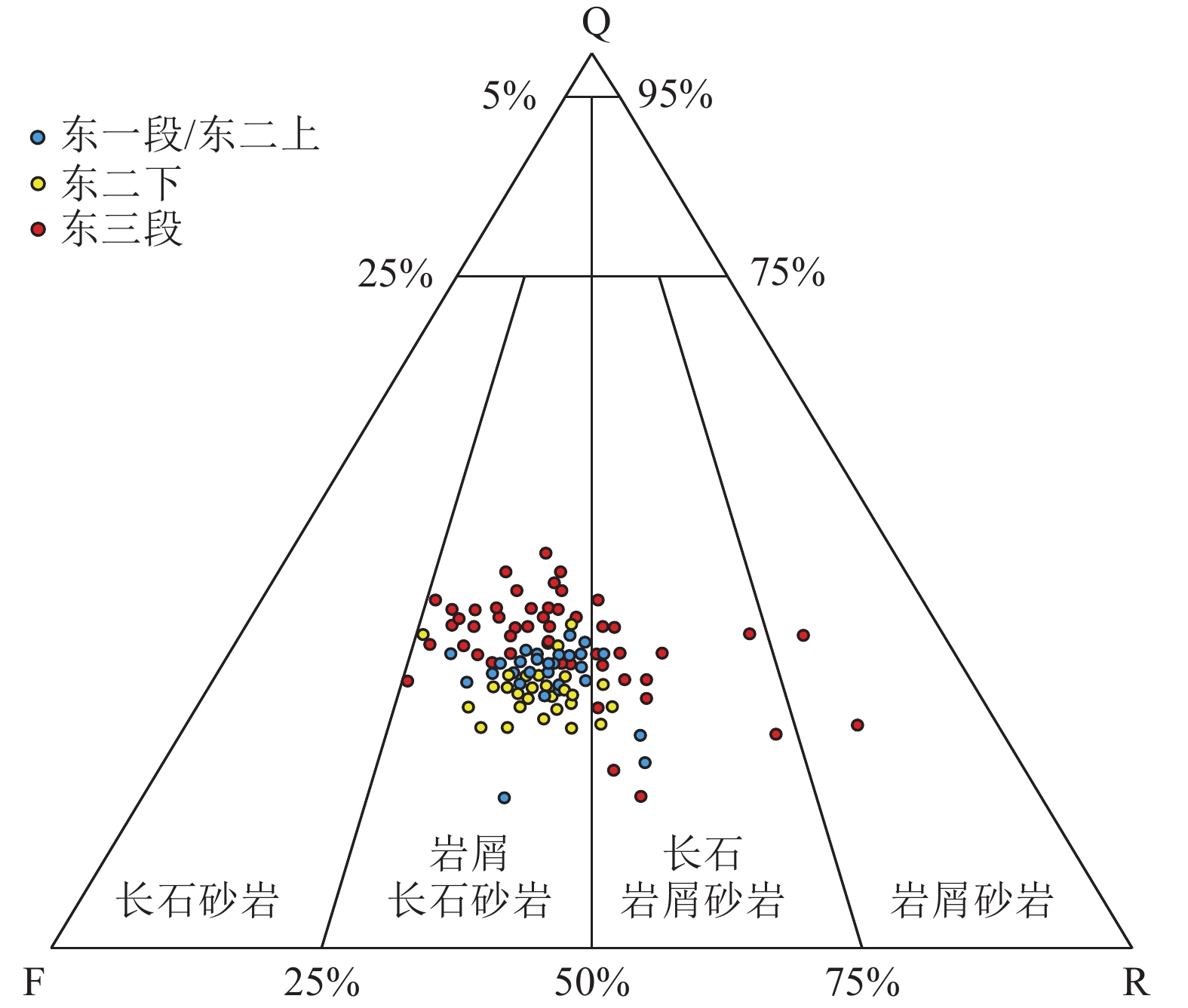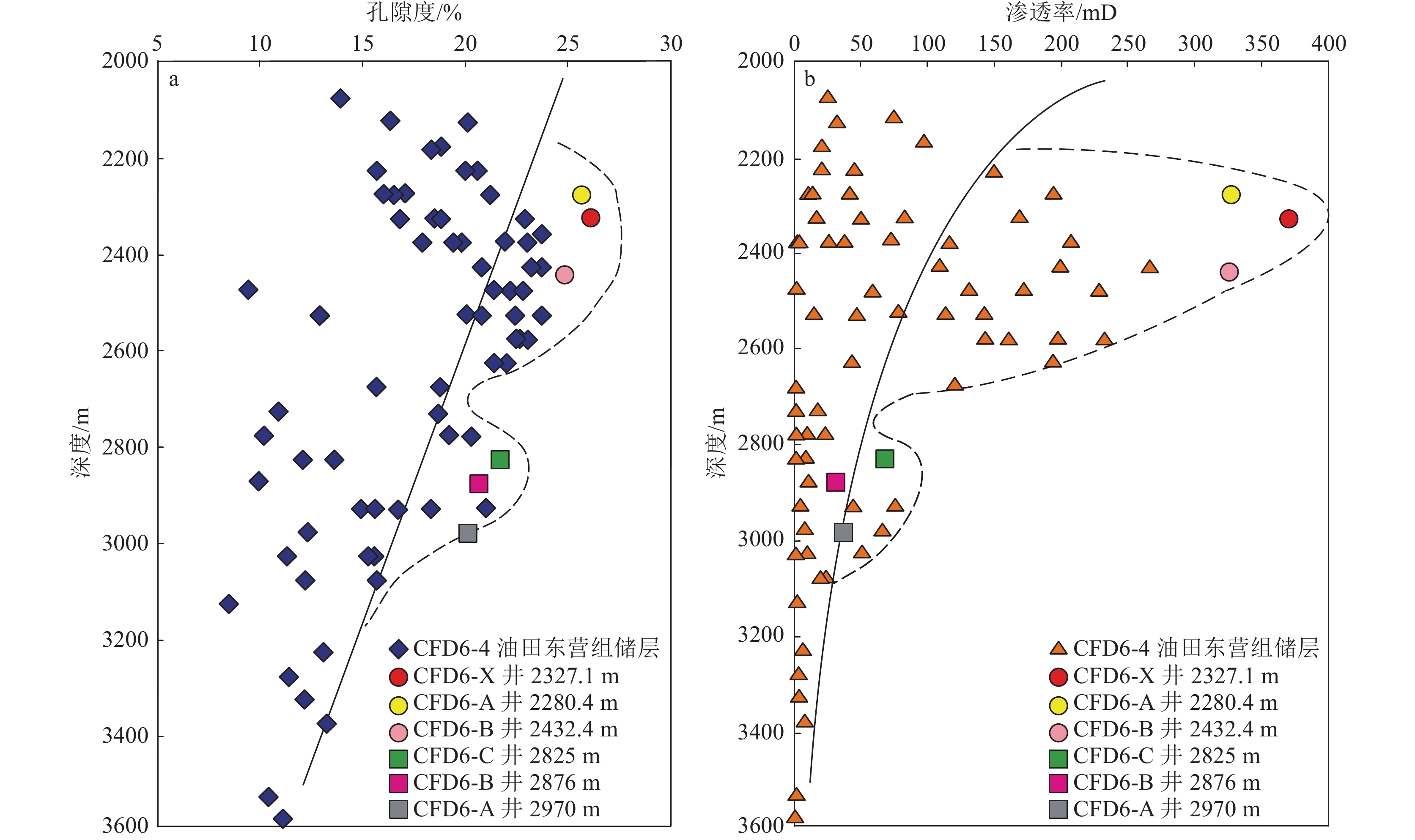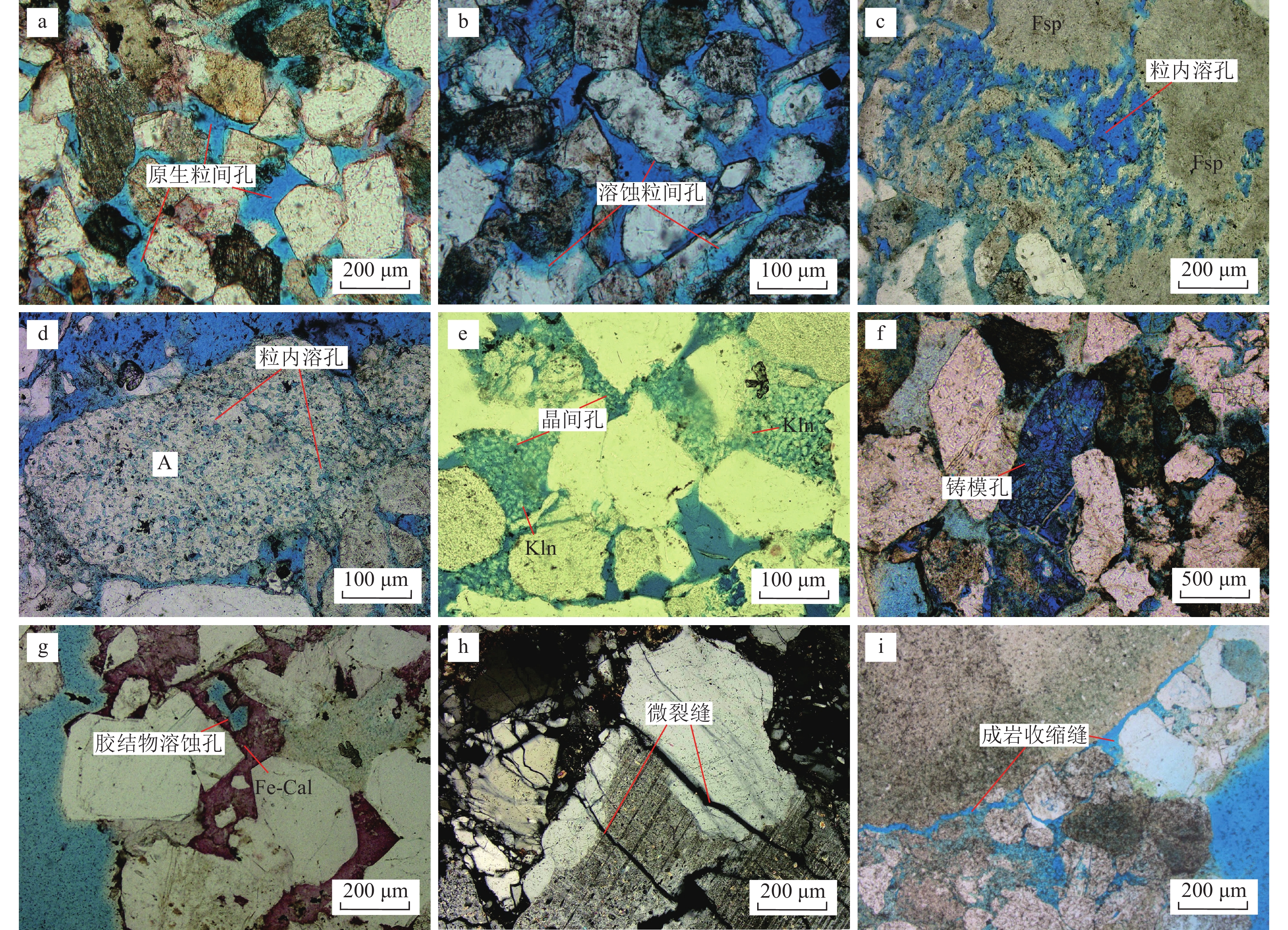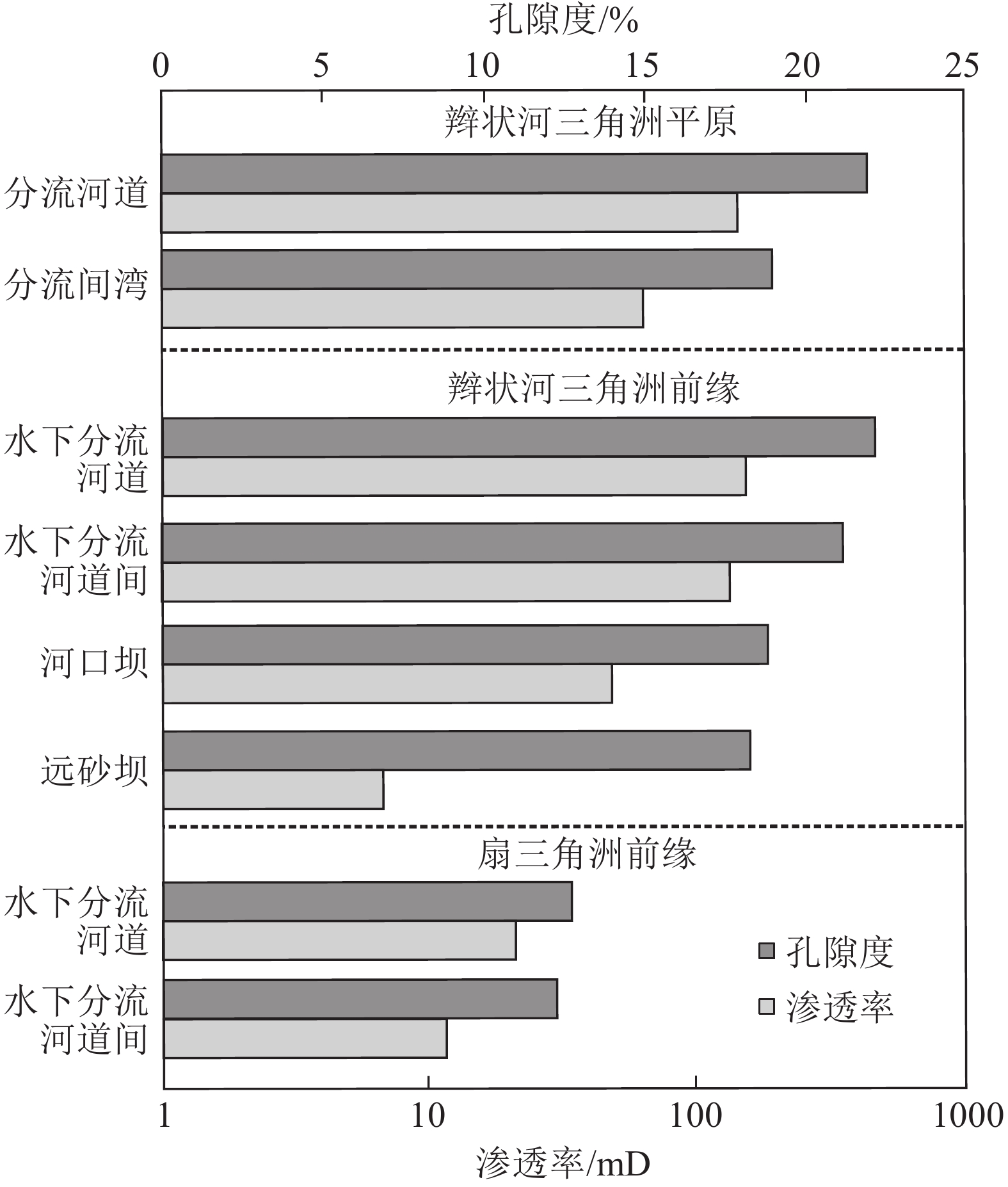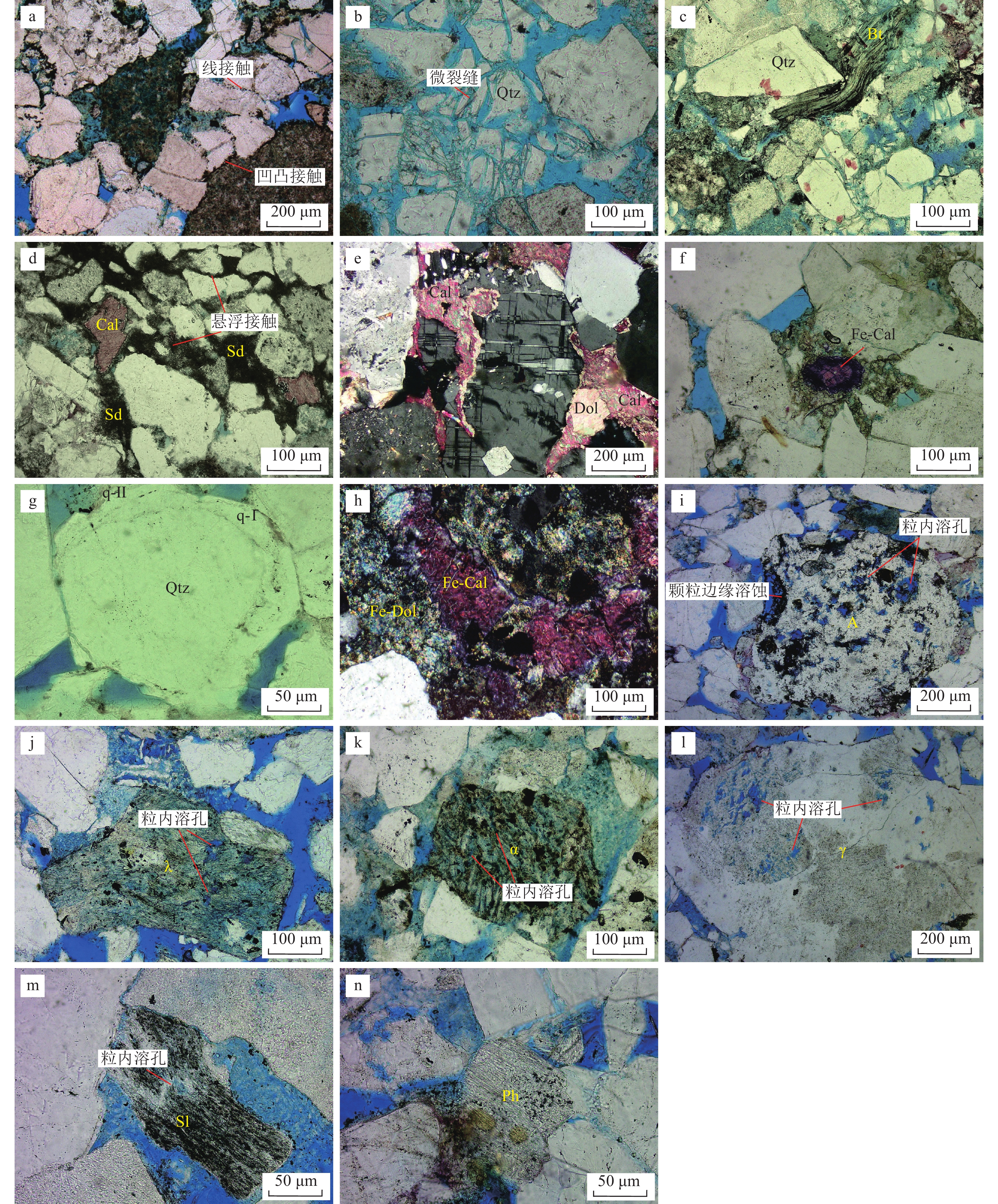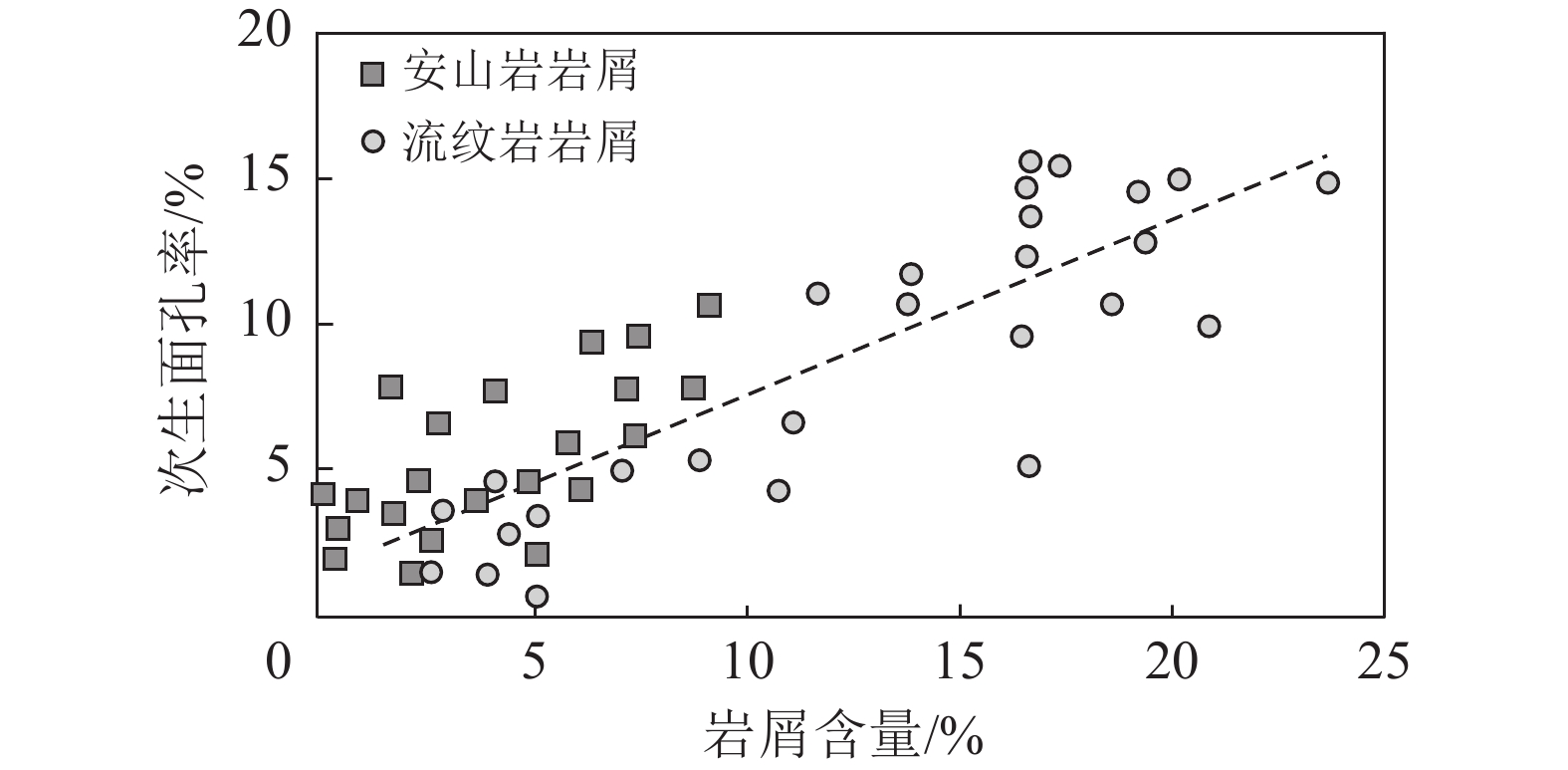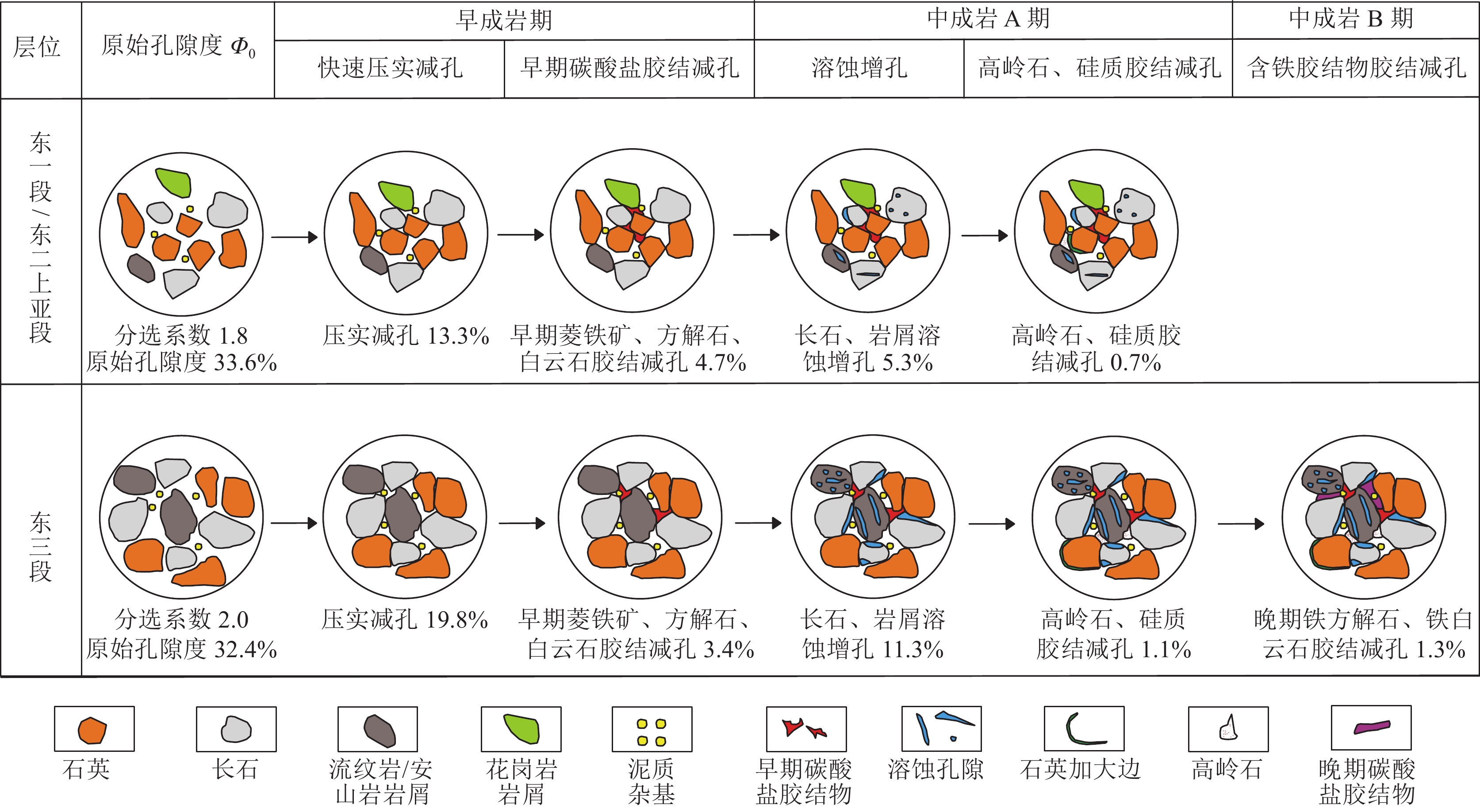Reservoir characteristics and controlling factors of physical properties of the Dongying Formation of the CFD6−4 Oilfield in the Bozhong Sag
-
摘要:
曹妃甸6−4油田为渤海中西部发现的优质整装中型油田,但实钻结果表明,该区东营组储层物性差异较大,储层特征及物性控制因素尚不明确。为了解决曹妃甸6-4油田勘探过程中有利储层的预测难题,基于普通薄片、铸体薄片、扫描电镜、物性、粒度等测试手段和数据,进行了储层岩石学、成岩作用、物性及储集空间特征研究。研究结果揭示:①储层主要为中—细粒岩屑长石砂岩,成分成熟度低,结构成熟度中等—低,储集空间整体以次生溶孔为主。②储层物性控制因素包括沉积微相、岩屑类型及成岩作用。其中辫状河三角洲前缘水下分流河道、辫状河三角洲平原分流河道及扇三角洲前缘水下分流河道对应的砂体粒度大、分选性好、抗压实能力强,有利于原生孔隙的保存,为主控有利储层的沉积微相类型;流纹岩及安山岩中长石含量较高,易发生溶蚀作用形成次生孔隙,改善储层物性,为有利岩屑类型;研究区储层物性受成岩作用改变明显,主控有利储层的成岩相类型为强溶蚀相、中等压实相及弱胶结相。③东营组储层发育2个异常高孔渗带,第一异常高孔渗带是在相对弱压实的背景下,由优势沉积微相控制的;第二异常高孔渗带由优势母岩类型和强溶蚀作用共同控制。
Abstract:CFD6−4 Oilfield is a high−quality, fully−loaded medium−sized oil field discovered in the west−central Bohai Sea. However, drilling results indicate that the reservoir properties of the Dongying Formation in this area are highly variable, the reservoir characteristics and controlling factors of physical property are still unclear. In order to solve the problem of predicting favorable reservoirs in the exploration process of CFD6−4 oil field, the petrology, diagenesis, physical properties and reservoir space characteristics are studied based on the test methods and data of ordinary and casting thin section, scanning electron microscopy, physical properties and grain size analysis.The results of the study revealed that:①The lithologic of the reservoir are mainly medium−fine grained debris−feldspathic sandstones with low composition maturity and medium−low textural maturity. The reserving space is mainly secondary dissolved pores. ②The controlling factors of physical properties include sedimentary microfacies, type of cuttings and diagenesis. Among them, distributary channel of the braided delta front and distributary channel of braided delta plain including distributary channel of fan delta front underwater are the sedimentary microfacies type of the main control favorable reservoir,which have larger grain size, good sorting and strong anti−compaction ability, is conducive to the preservation of primary pores. Rhyolite and andesite are the favorable debris type,which have more content of feldspar are more likely to dissolve and form secondary pores, improving the reservoir physical properties.The reservoir physical properties in the study area are obviously changed by diagenesis, the diagenetic facies types that mainly control the high quality reservoir are strong dissolution facies, medium compaction facies and weak cementation facies.③Two anomalously high porosity and permeability zones were found in this area. The first is controlled mainly by the sedimentary microfacies in the background of relatively weak compaction while the second is controlled by the type of parent rock and strong dissolution.
-
海洋石油钻探具有作业成本高、难度大、资料缺乏、研究程度偏低的特点。近年来,随着钻井技术水平的不断进步,渤海海域油气勘探已逐渐从浅层转移至中深层,而中深层优质储层的发育往往受沉积环境(钟大康等,2008;邱隆伟等,2015)、成岩作用(曲希玉等,2015a;操应长等,2018;曹英权等,2020)、地层压力(郝芳等,2006;刘小平等,2009;Nguyen et al.,2013)、构造运动(薛永安等,2016;王冠民等,2018;吴浩等,2019)、烃类充注(代黎明等,2017)等多因素的综合影响。因此,明确储层特征、探明储层物性影响因素,对下一步高效勘探开发具有重要的理论和实际意义,也是海洋油气高效勘探的重点和难点。CFD6−4油田古近系储层埋深普遍大于3000 m,为中深层储层,受成岩作用改造强烈,储层非均质性强。现阶段,针对该地区的研究主要集中在物源(代黎明等,2017)、断层(牛成民等,2016;庞小军等,2016)、古地貌(王启明等,2016;王清斌等,2018;王德英等,2020)等宏观成藏机理方面,然而该地区相同层位、相同深度,不同井区之间的储层物性差异较大,受限于勘探程度较低、地质获取资料难度大,研究区优质储层的发育机理研究较滞后,特别是针对微观储层特征及物性控制因素(尤其是岩屑类型)的研究较少,制约了油气的高效勘探开发。针对优质储层的成因、储层物性控制因素等科学问题,本文选取CFD6−4油田分析化验资料较齐全的6口探井,利用普通薄片、铸体薄片、扫描电镜、物性、粒度等测试手段和数据,综合研究储层岩石学、成岩作用、物性及储集空间特征,总结储层物性的控制因素,明确有利储层的成因,以期为相似背景下的有利储层预测和油气的高效勘探开发提供理论依据。
1. 地质概况
渤中凹陷是渤海湾盆地的沉降、沉积及生油中心,四周被凸起环绕,具有面积大、沉积厚度大的特点。其构造演化具有叠加多旋回性特征,自古近纪经历了2个裂陷−坳陷旋回及新构造再运动旋回(蔡东升等,2001;侯贵廷等,2001)。CFD6−4油田位于渤中凹陷石臼坨凸起西部陡坡带,南邻渤中凹陷西次洼,西接南堡凹陷,是具有优越成藏条件的复式油气聚集区(孙藏军等,2019)。该区于2014年开始钻探,不仅显示了良好的储层物性,而且在东营组发现大量油气,三级石油地质储量4055.21×104 t,说明该区具有较大的油气勘探潜力(万琳等,2017)。
研究区东营组自上而下可划分为东一段(Ed1)、东二上亚段(Ed2u)、东二下亚段(Ed2l)及东三段(Ed3)(图1−a)(龚再升等,2000;姜福杰等,2011)。东一段和东二段发育辫状河三角洲沉积相(李慧勇等,2018),上部发育辫状河三角洲平原亚相(图1−b),岩性特征为薄—厚层浅灰色粉砂岩、灰质粉砂岩、细砂岩、含砾细砂岩、含砾中砂岩与中—厚层灰绿色泥岩互层,主要沉积微相类型包括辫状河三角洲平原分流河道、分流间湾;中部发育辫状河三角洲前缘亚相(图1−c),岩性特征为薄—厚层粉砂岩、灰质粉砂岩、细砂岩、含砾细砂岩与褐灰色泥岩不等厚互层,主要沉积微相类型包括辫状河三角洲前缘水下分流河道、水下分流河道间、席状砂及远砂坝;中下部发育前辫状河三角洲亚相,岩性特征为厚层褐灰色泥岩夹灰白色泥质粉砂岩;底部发育半深湖—深湖亚相,岩性为厚层褐灰色泥岩。东三段发育扇三角洲前缘亚相(图1−d),岩性特征为厚层浅灰色细砂岩、含砾细砂岩、高岭土质细砂岩、砂砾岩夹薄层褐灰色泥岩,主要沉积微相类型包括扇三角洲前缘水下分流河道及水下分流河道间。
2. 储层特征
2.1 储层岩石学特征
本次对研究区6口探井173个铸体薄片进行了统计分析,东营组岩性以细砂岩(36.7%)、中砂岩(35.1%)为主,少量粗砂岩(13.5%)、粉砂岩(8.8%)及砾岩(5.9%),砂岩岩石类型以岩屑长石砂岩(75.3%)为主,部分长石岩屑砂岩(22.5%)及少量的岩屑砂岩(2.2%)(图2)。碎屑颗粒中石英含量为32.1% ~ 45.0%,平均36.2%;钾长石含量为15.8% ~ 32.4%,平均23.7%;斜长石含量为3% ~ 22.3%,平均10.3%;黑云母、燧石及沉积岩岩屑含量平均含量分别为0.6%,0.8%和0.1%;火成岩岩屑含量为6.3% ~ 18.1%,平均13.4%,主要为流纹岩、花岗岩及安山岩;变质岩岩屑含量为7.1% ~ 22.3%,平均14.6%,主要为石英岩、片麻岩、片岩、板岩及千枚岩(表1);填隙物中杂基含量为0 ~ 15.0%,平均3.6%;胶结物中菱铁矿含量为0 ~ 17.1%,平均2.5%;白云石含量为0 ~ 37.2%,平均2.0%;铁白云石含量为0 ~ 30.1%,平均1.9%;粘土矿物胶结物主要为高岭石,含量为0 ~ 12.9%,平均1.2%。Q/(F+R)值为0.20 ~ 0.72,平均0.51,成分成熟度较低。颗粒的分选性中等—差,磨圆度较差,主要为棱角—次棱角状,接触方式主要为点−线接触,结构成熟度中等—低,指示沉积物搬运距离短。
表 1 研究区储层碎屑组分含量Table 1. Clastic component of the reservoir in the research area% 井号 薄片数 石英 钾长石 斜长石 黑云母 燧石 沉积岩岩屑 流纹岩 安山岩 花岗岩 片麻岩 石英岩 千枚岩 片岩 板岩 CFD6−A 21 34.8 23.8 16.2 1.3 0.9 0.6 12 1.7 3.5 0 3.5 0.9 0 0.8 CFD6−B 84 34.1 24.9 13.5 0.6 0.8 1.3 12.2 1.6 3.3 1.8 4.9 0.7 0.3 0 CFD6−C 28 33.2 23.1 16.4 0.7 0.2 0.2 8.4 5.6 4.7 1.3 4.7 0.8 0.3 0.4 CFD6−X 30 37.9 27.1 13.3 0.2 1.7 0 4.3 2.2 2.1 3.7 6.7 0.3 0.2 0.3 CFD6−Y 5 37.7 25 11.6 0 0.6 0 8.5 3.2 2.2 2.2 6.5 0.8 0.7 1 CFD6−Z 5 37.8 28 10.6 0 0 0 3.4 0.8 13.4 1.3 4.4 0.1 0 0.2 2.2 储层物性特征
测井解释资料表明,研究区储层孔隙度集中分布于10% ~ 25%之间,渗透率集中分布于10 ~ 500 mD之间。孔隙度、渗透率具有较好的线性关系,储集空间以孔隙为主。其中东一段/东二上亚段平均孔隙度为21.06%,渗透率为134.83 mD;东二下亚段平均孔隙度为19.9%,渗透率为89.86 mD;东三段平均孔隙度为13.3%,渗透率为41.62 mD。依据碎屑岩储层分类评价标准,东一段、东二段整体属于中孔中渗,东三段属于低孔低渗。储层物性随着深度的增加逐渐变差,但在深度2225 ~ 2600 m和2800 ~ 2975 m范围存在2个异常高孔渗带(图3),分别对应东一段/东二上亚段及东三段,属于研究区相对优质储层。
2.3 储集空间特征
通过镜下薄片观察和统计,研究区东营组储层储集空间类型包括原生孔隙、次生孔隙及微裂缝。原生孔隙主要为原生粒间孔(图版Ⅰ−a);次生孔主要包括溶蚀粒间孔(图版Ⅰ−b)、长石及岩屑颗粒的粒内溶孔(图版Ⅰ−c,d)、高岭石晶间孔(图版Ⅰ−e)、铸模孔(图版Ⅰ−f)及胶结物溶孔(图版Ⅰ−g);微裂缝主要为颗粒破裂(图版Ⅰ−h)及成岩收缩形成的微裂缝(图版Ⅰ−i)。不同层位的孔隙类型也有差异,其中,东一段/东二上亚段以原生粒间孔为主,原生面孔率为9.8%。随着埋藏深度的增加,压实作用增强,东二下亚段以溶蚀粒间孔为主,溶蚀粒间孔面孔率为9.1%。东三段以颗粒溶蚀孔为主,颗粒粒内溶蚀面孔率为5.3%。典型的压汞数据表明(李慧勇等,2018),储层具有较好的渗透率,其排驱压力为0.031 ~ 0.417 MPa,平均0.146 MPa。孔喉半径为0.204 ~ 7.460 μm,以细喉为主;孔喉分选以不均匀型为主,均质因数为0.113 ~ 0.461,平均0.225。
![]() a.原生粒间孔,CFD6−B井,2517.68 m(−);b.溶蚀粒间孔,CFD6−B井,2552 m(−);c.长石强烈溶蚀形成粒内溶孔,CFD6−A井,2979 m(−);d.酸性喷出岩岩屑溶蚀形成粒内溶孔,CFD6−A井,2970 m(−);e.蠕虫状高岭石晶间孔,CFD6−A井,3099 m(−);f.铸模孔,CFD6−Z井,1815 m(−);g.铁方解石胶结物溶孔,CFD6−C井,3143 m(−);h.颗粒破裂形成的微裂缝,CFD6−C井,2698 m( + );i.成岩收缩缝,CFD6−B井,3141.88 m(−)。Fsp—长石;A—酸性喷出岩;Kln—高岭石;Fe-Cal—铁方解石
a.原生粒间孔,CFD6−B井,2517.68 m(−);b.溶蚀粒间孔,CFD6−B井,2552 m(−);c.长石强烈溶蚀形成粒内溶孔,CFD6−A井,2979 m(−);d.酸性喷出岩岩屑溶蚀形成粒内溶孔,CFD6−A井,2970 m(−);e.蠕虫状高岭石晶间孔,CFD6−A井,3099 m(−);f.铸模孔,CFD6−Z井,1815 m(−);g.铁方解石胶结物溶孔,CFD6−C井,3143 m(−);h.颗粒破裂形成的微裂缝,CFD6−C井,2698 m( + );i.成岩收缩缝,CFD6−B井,3141.88 m(−)。Fsp—长石;A—酸性喷出岩;Kln—高岭石;Fe-Cal—铁方解石3. 储层物性控制因素
3.1 沉积微相对储层物性的影响
即便在同一沉积环境下,不同微相的物性也会存在较大差异。以辫状河三角洲前缘亚相为例,通过统计6口探井的颗粒粒度、泥质含量等数据(表2),水下分流河道储层形成时往往对应较强的水动力条件,泥质含量较低,沉积了大量的细砂岩及少量含砾砂岩,粒度更粗、分选性更好,具有较强的抗压实能力,颗粒之间的接触关系以点−线接触为主,更有利于原生孔隙的保存,因此储层物性条件最好。相比而言,水下分流河道间、席状砂、河口坝微相粒度更细、分选性差,灰质含量较高,碳酸盐胶结物充填粒间孔,减少原生孔隙,使储层物性变差。伴随着泥质含量增高,减弱了储层的抗压实能力,且不利于有机酸等酸性流体对储层的改造。
表 2 不同沉积微相的岩性和泥质含量Table 2. Statistical results of lithology and argillaceous content of different sedimentary microfacies沉积微相类型 不同类型的岩性占比 泥质含量 含砾中砂岩 含砾细砂岩 细砂岩 粉砂岩 灰质粉砂岩 水下分流河道 12.0% 10.3% 76.0% - 1.7% 10.7% 水下分流河道间 - - 76.0% 19.2% 4.8% 11.8% 席状砂 - - 25.0% 72.9% 2.1% 13.5% 河口坝 - - 50.0% 33.3% 16.7% 17.3% 通过统计6口探井不同沉积亚相中的沉积微相,并进行物性对比(图4)发现,在辫状河三角洲平原亚相中,分流河道的平均孔隙度、渗透率最高,分别为21.9%、146.1 mD;在辫状河三角洲前缘亚相中,水下分流河道的平均孔隙度、渗透率最高,分别为22.1%、152.7 mD;在扇三角洲前缘亚相中,水下分流河道的平均孔隙度分别为12.7%、20.9 mD,优于水下分流河道间微相。因此,确定优势沉积微相类型为辫状河三角洲平原分流河道、辫状河三角洲前缘水下分流河道及扇三角洲前缘水下分流河道。
3.2 成岩作用对储层物性的影响
3.2.1 压实作用
压实作用是导致研究区储层物性变差的主要原因(徐文礼等,2017)。东营组孔隙度、渗透率随深度增加下降梯度分别为0.72%/100 m、13.3 mD/100 m,表现为颗粒之间的接触关系随埋深增加,由点−线接触变为线接触甚至凹凸接触(图版Ⅱ−a),石英、花岗岩岩屑等刚性颗粒破裂形成裂缝(图版Ⅱ−b、图版Ⅰ−h),黑云母、泥质塑性颗粒发生变形(图版Ⅱ−c)。通过对研究区东三段塑性颗粒(黑云母、杂基、泥质岩屑及胶结物)含量与储层孔隙度、渗透率的统计发现,塑性颗粒含量越高,储层抗压能力越弱,储层物性越差,越不利于原生孔隙的保存。
为了定量表征成岩作用对于储层物性的影响,利用成岩相(袁静,2012)表征储层成岩作用的强度。首先依据Trask分选系数(公式1)与储层原始孔隙度的对应函数(Beard et al.,1973;Scherer.,1987)(公式2),计算出研究区储层的原始孔隙度为30.9% ~ 38.5%。
S0=(√Q1Q3) (1) Φ原始=20.91+22.9S0 (2) 式中:S0代表Trask分选系数;Q1代表粒度概率累计曲线上25%处的粒径大小;Q3代表粒度概率累计曲线上75%处的粒径大小;Φ原始代表储层原始孔隙度。
视压实率可作为定义压实作用强度的指标(公式3),其分级标准为:当视压实率小于30%时,压实程度弱,当视压实率为30% ~ 70%时,压实程度中等,当视压实率大于70%时,压实程度强(赖锦,2013)。
视压实率=原始孔隙体积−粒间体积原始孔隙体积×100% (3) 式中:粒间体积代表岩石铸体薄片中粒间孔隙体积与胶结物体积之和。
通过大量的铸体薄片镜下统计,计算储层的视压实率,并对研究区压实作用强度进行划分。研究区储层由于压实作用损失的孔隙度在9.5% ~ 29.7%之间,视压实率介于34.1% ~ 88.9%之间,压实程度整体上可划分为中等压实成岩相和强压实成岩相,平均压实减孔量分别为17.8%、27.2%,中等压实成岩相为研究区有利储层的优势成岩相,纵向上主要分布于东一段/东二上亚段。
![]() a.颗粒之间呈线接触及凹凸接触,CFD6−B井,3138.66 m(−);b.颗粒破裂形成的微裂缝,CFD6−C井,2698 m(−);c.黑云母压实变形,CFD6−A井,2236.5 m(−);d.方解石及菱铁矿胶结物,方解石交代菱铁矿,CFD6−A井, 3099 m(−);e.白云石及方解石胶结物,白云石交代方解石,CFD6−A井,2987 m( + );f.铁方解石及白云石胶结物,铁方解石交代白云石,CFD6−A井,2932 m(−);g.两期石英次生加大,CFD6−A井,2979 m(−);h.铁白云石及铁方解石胶结物,铁白云石交代铁方解石,CFD6−C井,3755 m( + );i.酸性喷出岩岩屑溶蚀,CFD6−A井,2970 m(−);j.流纹岩岩屑中长石微晶溶蚀,CFD6−A井,2970 m(−);k.安山岩岩屑溶蚀,CFD6−A井,2970 m(−);l.混合花岗岩岩屑中斜长石溶蚀,CFD6−A井,2970 m(−);m.板岩岩屑微弱溶蚀,CFD6−A井,2970 m(−);n.千枚岩岩屑基本未溶蚀,CFD6−4−1井,2970 m(−)。Qtz—石英;Bt—黑云母;Cal—方解石;Sd—菱铁矿;Dol—白云石;q-Ⅰ—第一期石英次生加大;q-Ⅱ—第二期石英次生加大;Fe-Dol—铁白云石;λ—流纹岩;α—安山岩;γ—花岗岩;Sl—板岩;Ph—千枚岩
a.颗粒之间呈线接触及凹凸接触,CFD6−B井,3138.66 m(−);b.颗粒破裂形成的微裂缝,CFD6−C井,2698 m(−);c.黑云母压实变形,CFD6−A井,2236.5 m(−);d.方解石及菱铁矿胶结物,方解石交代菱铁矿,CFD6−A井, 3099 m(−);e.白云石及方解石胶结物,白云石交代方解石,CFD6−A井,2987 m( + );f.铁方解石及白云石胶结物,铁方解石交代白云石,CFD6−A井,2932 m(−);g.两期石英次生加大,CFD6−A井,2979 m(−);h.铁白云石及铁方解石胶结物,铁白云石交代铁方解石,CFD6−C井,3755 m( + );i.酸性喷出岩岩屑溶蚀,CFD6−A井,2970 m(−);j.流纹岩岩屑中长石微晶溶蚀,CFD6−A井,2970 m(−);k.安山岩岩屑溶蚀,CFD6−A井,2970 m(−);l.混合花岗岩岩屑中斜长石溶蚀,CFD6−A井,2970 m(−);m.板岩岩屑微弱溶蚀,CFD6−A井,2970 m(−);n.千枚岩岩屑基本未溶蚀,CFD6−4−1井,2970 m(−)。Qtz—石英;Bt—黑云母;Cal—方解石;Sd—菱铁矿;Dol—白云石;q-Ⅰ—第一期石英次生加大;q-Ⅱ—第二期石英次生加大;Fe-Dol—铁白云石;λ—流纹岩;α—安山岩;γ—花岗岩;Sl—板岩;Ph—千枚岩3.2.2 胶结作用
研究区东营组储层胶结作用类型可见碳酸盐胶结、硅质胶结及粘土矿物胶结,其中以碳酸盐胶结为主。
早成岩期,受压实作用影响,泥岩中的Ca2+和HCO3−得到释放进入砂岩中(陈思芮等,2022),在地层水主要呈碱性的条件下,形成了以菱铁矿、方解石及白云石为主的碳酸盐胶结物。其中,菱铁矿胶结物含量最高(57.2%),一般呈粒状、团块状充填孔隙,其大量发育的位置,颗粒一般呈点接触或悬浮接触(图版Ⅱ−d),方解石、白云石多以团块状、假杂基状、粒状出现,以基底式、接触式充填粒间孔(图版Ⅱ−d ~ f)。中成岩A期,地温有利于烃源岩排酸,长石和岩屑中的易溶解矿物发生溶蚀作用,随着地层水中Si4+、Al3+达到饱和,形成了自生高岭石胶结物(图版Ⅰ−e)及石英次生加大边(图版Ⅱ−g)。中成岩B期,油气充注使地层水变为碱性环境,伴随着泥岩孔隙水的排放及粘土矿物的转化作用,释放出Fe2+,在高温缺氧的还原环境下形成了以斑块状、团块状为主的铁方解石、铁白云石胶结物。
据研究区镜下薄片统计可知,胶结物含量较高时会堵塞孔隙,减小喉道的连通性,尤其是当胶结物含量大于10%时会使储层致密化,酸性流体难以进入储层发生溶蚀改造,从而严重影响储层渗透率。
视胶结率可作为定义胶结作用强度的指标(公式4),其分级标准为:当视胶结率小于30%时,胶结程度弱,当视胶结率为30% ~ 70%时,胶结程度中等,当视胶结率大于70%时,胶结程度强。
视胶结率=胶结物总量粒间体积×100% (4) 式中:胶结物总量为岩石铸体薄片中胶结物含量百分比值;粒间体积代表岩石铸体薄片中粒间孔隙体积与胶结物体积之和。
通过大量的铸体薄片镜下统计,计算储层的视压实率,并对研究区胶结作用强度进行划分。利用薄片鉴定中胶结物总量和粒间孔隙体积计算出的视胶结率介于0.8% ~ 75.2%之间。胶结程度整体上可划分为弱胶结成岩相、中等胶结成岩相和强胶结成岩相,平均胶结减孔量分别为2.4%、5.8%、13.1%。弱胶结成岩相为研究区有利储层的优势成岩相,纵向上主要发育在东一段/东二上亚段,平面上主要分布在研究区东部。
3.2.3 溶蚀作用
研究区溶蚀作用十分发育,镜下可见长石及火山岩岩屑颗粒边缘呈“港湾状”(图版Ⅰ−b、图版Ⅱ−i)、粒内“斑点状”、“蜂窝状”溶蚀(图版Ⅰ−d、图版Ⅱ−i,k ~ n)。溶蚀作用对CFD6-4地区储层物性的改善至关重要,东营组孔隙类型中次生孔隙占总孔隙的62.4%,其中东三段溶蚀作用形成的次生孔隙占总孔隙的78.4%,高岭石胶结物的发育(图版Ⅰ−e)也证实研究区储层长期经历酸性溶蚀作用。溶蚀作用的发育,主要是因为东营组长石(含量26.6% ~ 46.4%)、流纹岩、安山岩岩屑(含量2.1% ~ 14.2%)的高含量为溶蚀作用提供了优越的基础条件。此外,东营组沉积期构造抬升造成的大气淡水的淋滤溶蚀(远光辉等,2015),以及有机质在成熟阶段形成的大量有机酸,在有利的保存条件(流体包裹体均一温度98 ~ 120 ℃)下,对不稳定组分的长时间溶蚀(曲希玉等,2015b;李慧勇等,2018),导致大量次生孔隙的形成,从而改善了储层物性。
视溶蚀率可作为定义溶蚀作用强度的指标(公式5),其分级标准为:当视溶蚀率小于30%时,溶蚀程度弱,当视溶蚀率为30% ~ 70%时,溶蚀程度中等,当视溶蚀率大于70%时,溶蚀程度强。
视溶蚀率=溶蚀面孔率总面孔率×100% (5) 式中:溶蚀面孔率代表铸体薄片鉴定中由于溶蚀作用产生的次生面孔率;总面孔率为原生面孔率与次生面孔率之和。
利用视溶蚀率对研究区胶结作用强度进行划分,通过对薄片鉴定中溶蚀面孔率和总面孔率的统计,长石、岩屑等易溶矿物溶解后增加的孔隙度介于1.6% ~ 17.3%之间,平均为6.1%,计算出的视溶蚀率介于19.1% ~ 92.2%之间。研究区的溶蚀程度整体上可划分为弱溶蚀成岩相、中等溶蚀成岩相和强溶蚀成岩相,平均溶蚀增孔量分别为3.2%、5.0%、9.5%。强溶蚀相为研究区有利储层的优势成岩相,纵向上发育在东三段,平面上分布在研究区中部和东部。
3.3 岩屑类型对储层物性的影响
研究区母岩类型主要为中生代安山岩、凝灰岩、流纹岩及太古宙花岗岩,沉积物近源快速堆积的特点使不同井之间岩屑类型、含量差异明显(代黎明等,2017)。自西向东的CFD6−X井、CFD6−B及CFD6−A井,流纹岩和安山岩岩屑平均总含量分别为6.50%、11.8%、13.7%,通过对研究区铸体薄片进行面孔率定量分析可知,流纹岩、安山岩含量与储层次生面孔率呈明显的正相关关系(图5)。而在相同的地层条件(CFD6−A井2970 m)下,流纹岩、安山岩溶蚀增孔效果同样为最高(图版Ⅱ−j, k),平均溶蚀面孔率分别为17.43%、10.71%,为研究区优势岩屑类型;花岗岩平均溶蚀面孔率为8.18%(图版Ⅱ−m);板岩、千枚岩平均溶蚀面孔率分别为1.71%、0.54%(图版Ⅱ−n, o),溶蚀效果明显偏弱。
造成溶蚀作用差异的原因是岩屑中的主要矿物成分不同,岩浆岩岩屑中的长石含量往往高于变质岩,而长石含量高的岩屑普遍具有较好的溶蚀效果(曹英权等,2020)。此外,喷出岩经快速冷凝、结晶程度往往较差,岩石以玻璃质或显微晶质结构为主,基质在后期的成岩过程中经过脱玻化作用,增加了微孔隙,也为溶蚀作用提供了有利条件,因此喷出岩较其他类型的岩屑更易形成次生孔隙。
4. 有利储层的主控因素及成因
通过上述研究,东营组储层物性控制因素为沉积微相、岩屑类型及成岩作用。其中,有利储层的沉积微相类型为辫状河三角洲前缘水下分流河道、辫状河三角洲平原水下分流河道;岩屑类型为流纹岩及安山岩;成岩相类型为中等压实成岩相、弱胶结成岩相及强溶蚀成岩相。在不同深度和井位之间,储层物性由于控制因素的不同也出现了差异。依据储层实际的物性数据,结合沉积微相类型、岩屑类型及成岩作用强度,对研究区2个异常高孔隙带中有利储层的物性控制因素进行了总结(表3)。
表 3 储层物性控制因素Table 3. Statistical results of the controlling factors of reservoir physical property井名 深度/m 孔隙度/% 渗透率/mD 沉积微相 岩屑类型 压实作用 胶结作用 溶蚀作用 CFD6−X 2327.1 26 389.6 辫状河三角洲平原分流河道▲ 石英岩+花岗岩 中等压实▲ 中等胶结 中等溶蚀 CFD6−A 2280.4 25.6 345 辫状河三角洲平原分流河道▲ 流纹岩▲ 中等压实▲ 弱胶结▲ 中等溶蚀 CFD6−B 2432.4 24.1 341 辫状河三角洲前缘水下分流河道▲ 流纹岩+安山岩▲ 中等压实▲ 中等胶结 强溶蚀▲ CFD6−A 2970 20.6 33.7 扇三角洲前缘水下分流河道▲ 流纹岩▲ 中等压实▲ 弱胶结▲ 强溶蚀▲ CFD6−B 2876 20.9 29.5 扇三角洲前缘水下分流河道间 流纹岩▲ 中等压实▲ 中等胶结 强溶蚀▲ CFD6−C 2825 22.1 68.2 扇三角洲前缘水下分流河道▲ 流纹岩+安山岩▲ 强压实 中等胶结 强溶蚀▲ 注:“▲”代表有利储层的物性控制因素 第一异常高孔渗带(即东一段及东二上亚段)对应的有利储层是在相对弱压实(普遍为中等压实成岩相)的背景下,主要受沉积微相控制。岩石薄片镜下特征为:颗粒之间的接触关系主要为点−线接触和点接触;原生孔隙较发育,含量7.3%(全区平均为5.3%);泥质杂基含量偏低,为2.3%(全区平均3.6%);胶结物含量较低,为2.7%(全区平均含量4.1%);见少量长石及部分岩屑溶蚀,次生面孔率为6.3%(全区平均6.0%)。该深度段的有利储层具有优越的先天条件,沉积微相类型主要为辫状河三角洲平原分流河道及辫状河三角洲前缘水下分流河道,岩石具有分选性好、刚性颗粒含量高、泥质含量低、砂体抗压实能力强、原生孔隙发育的特点。此外,储层受胶结作用较弱、溶蚀作用较强,也在一定程度上改善了该深度段的储层物性。以CFD6−X井2327.1 m为例,孔隙度和渗透率分别为26.0%和389.6 mD(图3),属于研究区东一段/东二上亚段相对优质的高孔中渗储层。其孔隙演化过程如图6所示:沉积微相为辫状河三角洲平原水下分流河道,石英含量较高,泥质杂基含量较少,分选性好,分选系数1.8,原始孔隙度33.6%。中等压实成岩相使压实减孔量较少,有利储层的形成主要受优势沉积微相、优势压实成岩作用控制。
第二异常高孔渗带(即东三段)对应的有利储层主要由优势岩屑类型和强溶蚀作用共同控制。镜下特征为:颗粒之间的接触关系主要为点−线;与原生孔隙相比,次生孔隙含量高,可见大量长石、流纹岩及安山岩岩屑粒内溶孔,达到7.8%(全区平均6.0%);高岭石胶结物平均含量0.8%,指示储层溶蚀作用强烈(全区平均0.3%)。流纹岩、安山岩、长石等易溶矿物含量较高,与酸性流体发生了强烈的溶蚀作用,产生大量的次生孔隙,是该深度段储层物性改善的主要原因。以CFD6−A井2970 m为例,孔隙度和渗透率分别为20.6%和33.7 mD(图3),属于研究区东三段相对优势的中孔低渗储层储层。孔隙演化过程如图6所示:沉积微相为扇三角洲前缘水下分流河道,压实作用强度为中等压实,长石、易溶蚀岩屑含量较高,在强溶蚀作用下形成了大量次生孔隙,改善了储层物性。同时,该有利储层也具有胶结作用较弱的特点,有利储层的形成由上述因素共同控制。
5. 结 论
(1)渤中凹陷CFD6−4油田东营组储层主要为中—细粒岩屑长石砂岩,主要岩屑类型为变质岩和岩浆岩,颗粒分选性中等—差,磨圆度较差,主要为棱角—次棱角状;颗粒间接触方式主要为点−线接触,结构成熟度中等—低,岩石学特征表现为搬运距离短、近物源。胶结作用主要表现为碳酸盐胶结,局部溶蚀作用强烈,储集空间以次生孔隙为主。
(2)CFD6−4油田东营组储层物性控制因素包括沉积微相、岩屑类型及成岩作用。其中,辫状河三角洲前缘水下分流河道、辫状河三角洲平原分流河道及扇三角洲前缘水下分流河道对应的砂体粒度大、分选性好、抗压实能力强,更有利于原生孔隙的保存,为主控有利储层的沉积微相类型;流纹岩及安山岩中长石含量较高,易发生溶蚀作用形成次生孔隙,改善储层物性,为优势岩屑类型;研究区储层物性受成岩作用改变明显,主控有利储层的成岩相类型为强溶蚀相、中等压实相及弱胶结相。由于地质背景差异,不同区域、深度之间的储层物性控制因素也不同,研究区有利储层的形成是上述多因素共同作用的结果。
(3)CFD6−4油田东一段及东二上亚段对应的优质储层是在相对弱压实的背景下,主要受沉积微相控制;东三段优质储层由岩屑类型和成岩作用共同控制。
-
表 1 研究区储层碎屑组分含量
Table 1 Clastic component of the reservoir in the research area
% 井号 薄片数 石英 钾长石 斜长石 黑云母 燧石 沉积岩岩屑 流纹岩 安山岩 花岗岩 片麻岩 石英岩 千枚岩 片岩 板岩 CFD6−A 21 34.8 23.8 16.2 1.3 0.9 0.6 12 1.7 3.5 0 3.5 0.9 0 0.8 CFD6−B 84 34.1 24.9 13.5 0.6 0.8 1.3 12.2 1.6 3.3 1.8 4.9 0.7 0.3 0 CFD6−C 28 33.2 23.1 16.4 0.7 0.2 0.2 8.4 5.6 4.7 1.3 4.7 0.8 0.3 0.4 CFD6−X 30 37.9 27.1 13.3 0.2 1.7 0 4.3 2.2 2.1 3.7 6.7 0.3 0.2 0.3 CFD6−Y 5 37.7 25 11.6 0 0.6 0 8.5 3.2 2.2 2.2 6.5 0.8 0.7 1 CFD6−Z 5 37.8 28 10.6 0 0 0 3.4 0.8 13.4 1.3 4.4 0.1 0 0.2 表 2 不同沉积微相的岩性和泥质含量
Table 2 Statistical results of lithology and argillaceous content of different sedimentary microfacies
沉积微相类型 不同类型的岩性占比 泥质含量 含砾中砂岩 含砾细砂岩 细砂岩 粉砂岩 灰质粉砂岩 水下分流河道 12.0% 10.3% 76.0% - 1.7% 10.7% 水下分流河道间 - - 76.0% 19.2% 4.8% 11.8% 席状砂 - - 25.0% 72.9% 2.1% 13.5% 河口坝 - - 50.0% 33.3% 16.7% 17.3% 表 3 储层物性控制因素
Table 3 Statistical results of the controlling factors of reservoir physical property
井名 深度/m 孔隙度/% 渗透率/mD 沉积微相 岩屑类型 压实作用 胶结作用 溶蚀作用 CFD6−X 2327.1 26 389.6 辫状河三角洲平原分流河道▲ 石英岩+花岗岩 中等压实▲ 中等胶结 中等溶蚀 CFD6−A 2280.4 25.6 345 辫状河三角洲平原分流河道▲ 流纹岩▲ 中等压实▲ 弱胶结▲ 中等溶蚀 CFD6−B 2432.4 24.1 341 辫状河三角洲前缘水下分流河道▲ 流纹岩+安山岩▲ 中等压实▲ 中等胶结 强溶蚀▲ CFD6−A 2970 20.6 33.7 扇三角洲前缘水下分流河道▲ 流纹岩▲ 中等压实▲ 弱胶结▲ 强溶蚀▲ CFD6−B 2876 20.9 29.5 扇三角洲前缘水下分流河道间 流纹岩▲ 中等压实▲ 中等胶结 强溶蚀▲ CFD6−C 2825 22.1 68.2 扇三角洲前缘水下分流河道▲ 流纹岩+安山岩▲ 强压实 中等胶结 强溶蚀▲ 注:“▲”代表有利储层的物性控制因素 -
Beard D C, Weyl P K. 1973. Influence of texture on porosity and permeability of unsolidated sand[J]. AAPG Bulletin, 57(2): 349−369.
Nguyen B T, Jones S J, Goulty N R, et al. 2013. The role of fluid pressure and diagenetic cements for porosity preservation in Triassic fluvial reservoirs of the Central Graben, North Sea[J]. AAPG Bulletin, 97(8): 1273−1302. doi: 10.1306/01151311163
Scherer M. 1987. Parameters influencing porosity in sandstones: a model for sandstone porosity prediction[J]. AAPG Bulletin, 71(5): 485−491.
蔡东升, 罗毓晖, 武文来, 等. 2001. 渤海浅层构造变形特征、成因机理与渤中坳陷及其周围油气富集的关系[J]. 中国海上油气, 15(1): 35−43. 操应长, 杨田, 宋明水, 等. 2018. 陆相断陷湖盆低渗透碎屑岩储层特征及相对优质储层成因——以济阳坳陷东营凹陷古近系为例[J]. 石油学报, 39(7): 727−743. 曹英权, 王清斌, 曲希玉, 等. 2020. 岩屑的有机酸溶蚀实验及验证——以渤中凹陷CFD6−4油田东营组为例[J]. 石油学报, 41(7): 841−852. 陈思芮, 王卫学, 曲希玉, 等. 2022. 东营凹陷北带沙四上亚段砂砾岩储层物性主控因素分析[J]. 吉林大学学报(地球科学版), 52(4): 1091−1106. 代黎明, 徐长贵, 王清斌, 等. 2017. 石臼坨凸起西部陡坡带古物源差异演化模式及其对储层的控制作用[J]. 中国海上油气, 29(4): 51−59. 龚再升, 王国纯, 贺清. 2000. 上第三系是渤中坳陷及其周围油气勘探的主要领域[J]. 中国海上油气(地质), 14(3): 145−156. 郝芳, 邹华耀, 方勇, 等. 2006. 超压环境有机质热演化和生烃作用机理[J]. 石油学报, (5): 9−18. 侯贵廷, 钱祥麟, 蔡东升. 2001. 渤海湾盆地中、新生代构造演化研究[J]. 北京大学学报(自然科学版), 37(6): 845−850. 姜福杰, 庞雄奇. 2011. 环渤中凹陷油气资源潜力与分布定量评价[J]. 石油勘探与开发, 38(1): 23−29. 赖锦, 王贵文, 王书南, 等. 2013. 碎屑岩储层成岩相研究现状及进展[J]. 地球科学进展, 28(1): 39−50. 李慧勇, 胡安文, 于海波, 等. 2018. 石臼坨凸起西段陡坡带东营组三段储层特征及控制因素[J]. 东北石油大学学报, 42(4): 75−84, 9−10. 刘小平, 周心怀, 吕修祥, 等. 2009. 渤海海域油气分布特征及主控因素[J]. 石油与天然气地质, 30(4): 497−502,509. 牛成民, 杜晓峰, 邹华耀, 等. 2016. 渤海海域石臼坨凸起油气输导体系与运聚模式[J]. 中国海上油气, 28(3): 44−49. 庞小军, 王清斌, 张雪芳, 等. 2016. 渤海海域石臼坨凸起西南缘断层特征对油气成藏的控制作用[J]. 东北石油大学学报, 40(3): 32−40. 邱隆伟, 徐宁宁, 刘魁元, 等. 2015. 渤南洼陷沙四上亚段储层异常高孔带及优质储层成因机制[J]. 天然气地球科学, 26(1): 1−12. 曲希玉, 刘珍, 高媛, 等. 2015a. 绿泥石包壳对碎屑岩储层物性的影响及其形成环境——以鄂尔多斯盆地大牛地气田上古生界为例[J]. 沉积学报, 33(4): 786−794. 曲希玉, 陈修, 邱隆伟, 等. 2015b. 石英溶解型次生孔隙的成因及其对储层的影响——以大牛地气田上古生界致密砂岩储层为例[J]. 石油与天然气地质, 36(5): 804−813. 孙藏军, 别旭伟, 聂玲玲, 等. 2019. 渤海曹妃甸6−4油田东三段储层孔隙演化定量分析[J]. 中国海上油气, 31(6): 44−51. 万琳, 王清斌, 赵国祥, 等. 2017. 石臼坨凸起陡坡带东三段扇三角洲砂体成岩作用定量表征[J]. 大庆石油地质与开发, 36(6): 31−39. 王德英, 于娅, 张藜, 等. 2020. 渤海海域石臼坨凸起大型岩性油气藏成藏关键要素[J]. 岩性油气藏, 32(1): 1−10. 王冠民, 张婕, 王清斌, 等. 2018. 渤海湾盆地秦南凹陷东南缘中深层砂砾岩优质储层发育的控制因素[J]. 石油与天然气地质, 39(2): 330−339. 王启明, 李瑾, 周晓光, 等. 2016. 石臼坨凸起西南缘陡坡带东三段古地貌对沉积的控制[J]. 东北石油大学学报, 40(6): 53−61. 王清斌, 刘立, 牛成民, 等. 2018. 石臼坨凸起陡坡带大气淡水成岩环境对湖相混积岩储层的影响[J]. 地球科学, 43(S2): 234−242. 吴浩, 纪友亮, 周勇, 等. 2019. 南堡凹陷南部古近系深层优质储层成因[J]. 中国矿业大学学报, (3): 1−17. 徐文礼, 刘冉, 文华国, 等. 2017. 准噶尔盆地阜北地区下侏罗统三工河组二段成岩作用及成岩相[J]. 地质通报, 36(4): 555−564. 薛永安, 韦阿娟, 彭靖淞, 等. 2016. 渤海湾盆地渤海海域大中型油田成藏模式和规律[J]. 中国海上油气, 28(3): 10−19. 袁静, 袁凌荣, 杨学君, 等. 2012. 济阳坳陷古近系深部储层成岩演化模式[J]. 沉积学报, 30(2): 231−239. 远光辉, 操应长, 贾珍臻, 等. 2015. 含油气盆地中深层碎屑岩储层异常高孔带研究进展[J]. 天然气地球科学, 26(1): 28−42. 钟大康, 朱筱敏, 王红军. 2008. 中国深层优质碎屑岩储层特征与形成机理分析[J]. 中国科学: 地球科学, 38(增刊1): 11−18. -
期刊类型引用(4)
1. 朱文奇,昝春景,张莹,王涛,史朝文,巴李霞,陈亮,季汉成. 渤中凹陷西次洼古近系东营组异常高孔带特征及成因机制. 岩性油气藏. 2025(02): 70-80 .  百度学术
百度学术
2. 刘宗宾,李超,路研,王亚,黄建廷. 基于孔隙结构表征的低渗透砂岩流体赋存特征及渗透率评价. 吉林大学学报(地球科学版). 2024(04): 1124-1136 .  百度学术
百度学术
3. 李敏,张月霞,吴琼玲,李亚茹,向钰鉥,田鑫,张晴宇,李婉霖,孙梦迪,张艺凡,吴彦旺,管彦凯. 南海珠江口盆地陆丰凹陷文昌组沉积成岩特征及储层物性控制因素. 东北石油大学学报. 2024(04): 69-88+139-140 .  百度学术
百度学术
4. 刘翔宇,单玄龙,衣健,苏思远,李嘉慧,庞赫,邹玉洁. 渤海湾盆地渤中凹陷义县组火山喷发旋回及其分布规律. 吉林大学学报(地球科学版). 2024(06): 1829-1845 .  百度学术
百度学术
其他类型引用(0)



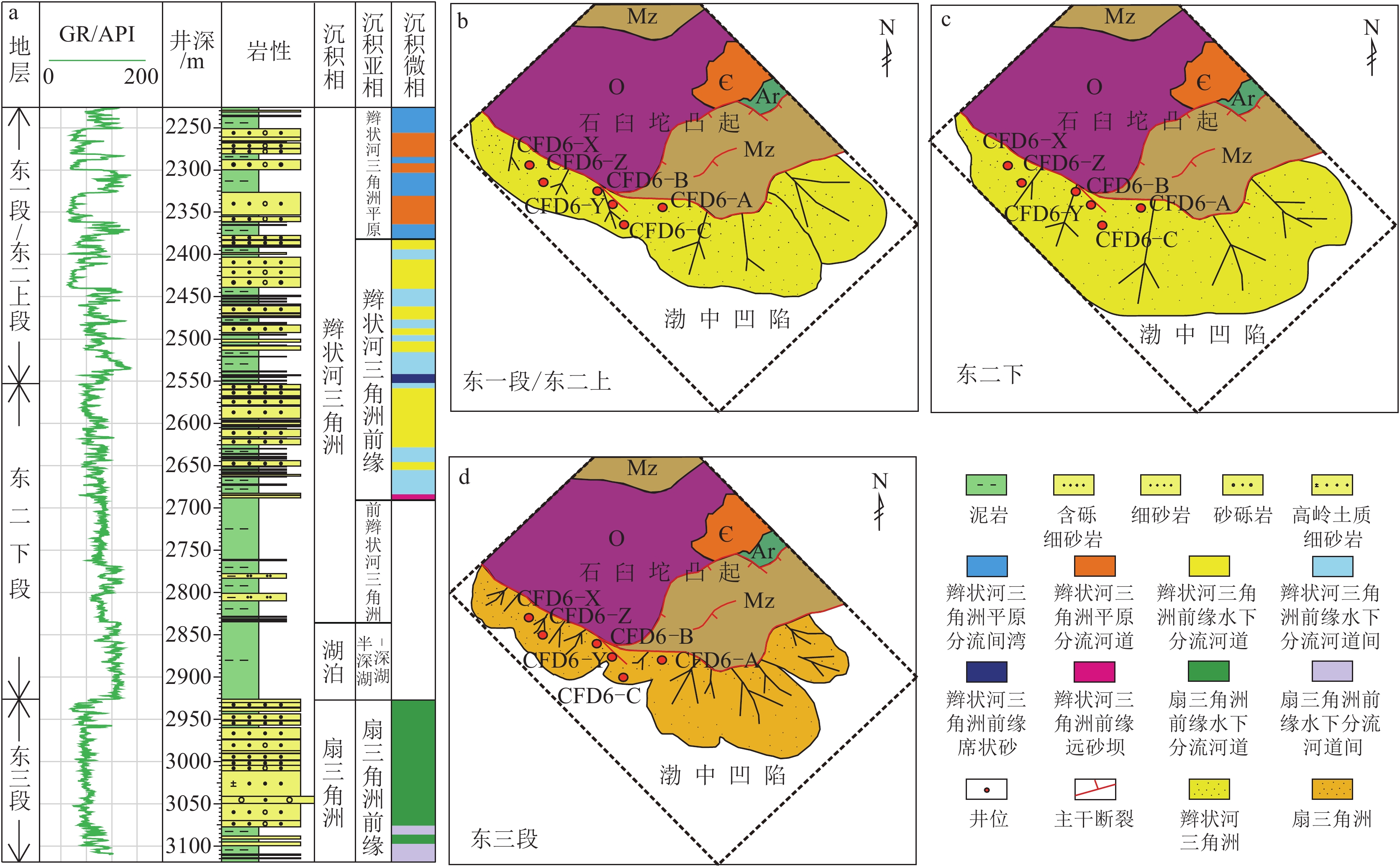
 下载:
下载:
